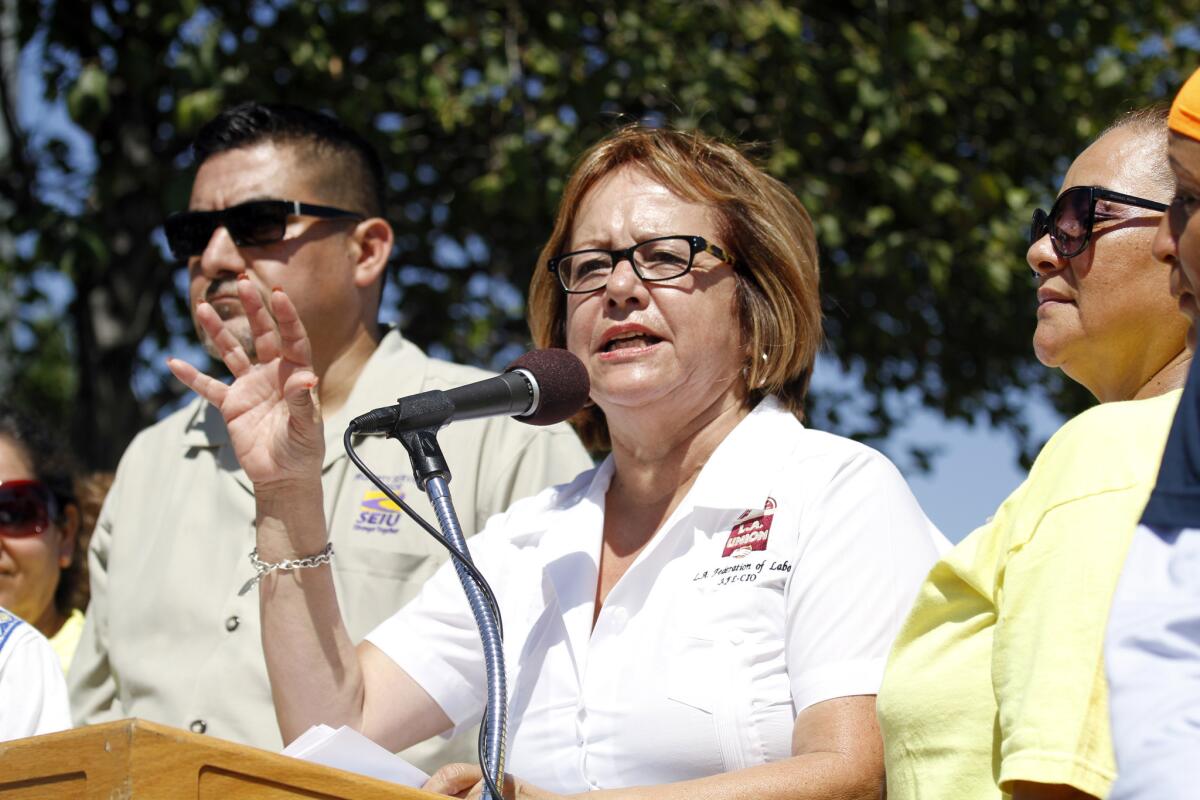On the minimum wage, the real issue isn’t inflation, but location

The AFL-CIO’s Maria Elena Durazo speaks at a 2014 rally in favor of L.A. Mayor
- Share via
One of the smarter ideas in the Los Angeles City Council’s move this month to raise the minimum wage to $15 an hour by 2020 is the inflation kicker: After that date, the wage would be permanently indexed to the cost of living.
That’s important because the difficulty of enacting any increase at all over the last few years has kept inflation as the low-wage worker’s implacable enemy. The federal minimum wage, currently $7.25 an hour, peaked in buying power way back in 1968, when it was fixed at $1.60 in nominal dollars, worth about $10.88 in today’s money. The California minimum wage that year was $1.65, or $11.22 in 2015 terms. State increases haven’t come close to keeping up with the rise in the cost of living: The state minimum, which is in effect today for L.A. and currently $9, is scheduled to rise only to $10 on Jan. 1.
Yet inflation is only part of the story -- and in some respects, not the most important part. The high overall cost of living in Los Angeles, and many other big cities, is what really puts low-income workers behind the curve, especially when compared to workers in other cities and regions. This factor has inspired the living wage movement in L.A. and elsewhere, which is directed at workers in certain industries such as hospitality. But it’s often overlooked in discussions of the minimum wage.
The difference warrants more attention. The general cost of living in L.A. is about 40% higher than the U.S. average, according to figures from the Council for Community and Economic Research. The number-crunchers at fivethirtyeight.com calculate that a $15 hourly minimum wage in 2020 would be worth about $9.76 to today’s average American worker. (Fivethirtyeight has adjusted the council’s figures to reflect the spending patterns of low-wage consumers.)
The regional differences in the value of the minimum wage are eye-opening. Among the nation’s best cities for minimum-wage employees is Columbus, Ohio, where the statutory minimum of $8.10 is worth $8.91 on an adjusted basis. Seattle, the first big city to move to a $15 minimum (over a period of several years), already has a relatively high minimum -- its current $11 is worth a comparative $8.51; in 2017, its $15 minimum will be worth a chart-topping $11.21, adjusted. The Midwest and South are hotbeds of minimum wages that are worth more in comparative terms than their face value -- Memphis, Indianapolis, Charlotte, and Jacksonville are among the cities that fall into that category.
In San Francisco, the city’s current $12.25 minimum wage buys workers only $7.03 worth of goods and services compared to average Americans; even when the $15 minimum goes into effect there in 2018, it will be worth only a comparable $8.18.
As one might expect, L.A.’s comparable value is near the bottom of the list, with the current $9 minimum worth only $6.38. That’s still enough to beat Manhattan, where the current minimum wage of $8.75 is worth only $3.86.
One might argue that such regional comparisons are largely irrelevant, since the minimum wage is paid by local businesses and low-wage workers have minimal mobility: it’s not necessarily practical for a family to move from L.A. to, say, Nashville, in quest of an effective minimum-wage hike of $1.72 an hour.
But the differences tell us a lot. The regions with the highest cost of living tend to be those with the highest levels of income inequality. These include not only Los Angeles, but the New York metropolitan area and South Florida. The cost of living often reflects spending by the high-wage sector, especially on housing.
That’s an important window into how income inequality affects people at all income levels. It’s fashionable among some economists to claim that income inequality shouldn’t matter to the middle-class and the poor because they’re not giving up anything to make the rich richer. “We should collectively be pleased by increases in income at the top, so long as they were not caused by taking ... from individuals at the bottom,” wrote Richard Epstein of the Hoover Institution in 2013.
But these figures imply that high inequality does leave those at the lowest end of the wage scale especially disadvantaged. Their rents and food prices are higher, and their wages buy less.
Keep up to date with the Economy Hub. Follow @hiltzikm on Twitter, see our Facebook page, or email mhiltzik@latimes.com.
More to Read
Inside the business of entertainment
The Wide Shot brings you news, analysis and insights on everything from streaming wars to production — and what it all means for the future.
You may occasionally receive promotional content from the Los Angeles Times.









